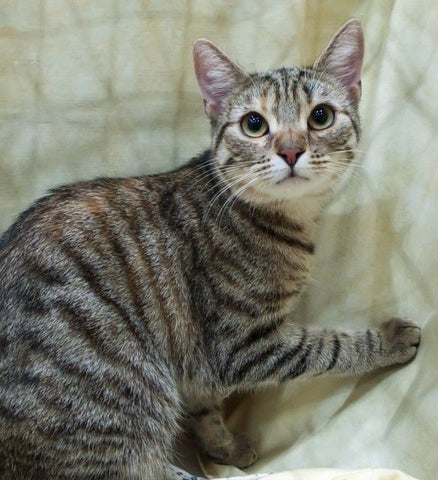

A blue tabby has a creamy background color and blue stripes while a cream tabby has a light beige background with darker beige stripes. A brown tabby has a warm brown or bronze tone to his background color and black stripes. Tabby colors are among the most difficult to for people to learn. Elaborately marked tabbies also may have bracelets, butterflies across the shoulders and necklaces – all dressed up to party! Each tabby-patterned cat also has the distinctive marking of an “M” on the forehead. Additionally, tabby cats have stripes or bars on the legs, buttons down the tummy, a spine line down the center of the back and rings around the tail. We call these mascara markings as they highlight the eyes and trace their way across the face. No matter what the tabby pattern of the domesticated cat, there are intricate markings present on the face. The patching seen in these cases is related to the sex-linked orange gene so the cat or kitten is most likely a female. If a cat is a brown, silver or blue tabby and she has patches of red or cream, she is a “patched tabby.” Her tabby pattern can be spotted, mackerel, classic or ticked.

We sometimes call this pattern the agouti tabby pattern (Abyssinians are a typical example). Finally, the ticked tabby appears as multiple bands of color on each hair on the body and head with barring on the legs and tail. The spotted tabby example is remindful of the mackerel or classic pattern except that the stripes or swirls appear to be broken into spots of color (Ocicats are a good example). The classic tabby pattern (the blotched tabby) is a pattern where there are elaborate swirls on the sides and butterflies over the shoulders. (Remember, Tabby is a pattern.) The mackerel pattern, which is the most common, is the pattern where the stripes are narrow and run parallel to one another like the bones of a fish (therefore the term, “mackerel”). There are several solid colors: white, blue, chocolate, cinnamon, lilac or lavender, red, cream, sable or brown and cream.Ī striped cat – a ” tabby” – may have one of four different patterns – mackerel, classic, spotted or ticked. If a cat is a black cat, we may describe him as a “black, solid colored cat.” A cream colored cat is called a “cream, solid color” and so on. Other characteristics that we may also construe as pattern, such as the shaded and the smoke effects, are also useful in descriptions of cats.Ĭats with only one color and without a tabby pattern or white spots are called “solid colored” cats. Many patterns occur in the domesticated cat: solid, tabby, parti-color, bi-color and pointed. Often, just a color does not describe a cat. Fortunately, a black cat is a black cat and a white cat is a white cat – no matter who is doing the naming – except of course, if you are talking about an ebony Oriental Shorthair, a black cat by any other name! “Yipes! Stripes!!” What about all those coat patterns? And, they may term a lavender-colored cat’s color lilac, lavender, platinum or frost, depending on the breed. There are many color names for a solid brown cat’s color such as sable, chocolate, chestnut or sepia. We term a yellow or beige cat a cream colored cat. For example, geneticists and breeders refer to a cat that is gray as a blue cat. There are two ways to describe color – what it looks like and what the experts call it. How do we describe a coat color?Ĭolor and pattern are the most common descriptors for the pedigreed show cat. One may, however, have a Tortoiseshell Persian or Cornish Rex or a Tabby Oriental or Maine Coon Cat. This holds true for the terms Calico and Tortoiseshell as well – both refer to the cat’s pattern.

For example, Tabby is a pattern – not a breed. These descriptors do not suggest the breed (if any) of the kitten or cat. When we describe the cat’s coat, the colors and patterns refer to exactly those elements of the animal – the coat – its color and pattern and length. If you have not yet made that purchase, this chapter will help you identify the colors and patterns you may see as you begin to search for that important first cat. If that is the case, you have already begun your education in the identification of the various coat colors and patterns among our beautiful pedigreed cats. Perhaps you have purchased your first cat for showing or breeding. Sign up for Newsletter or CFA Announcements.


 0 kommentar(er)
0 kommentar(er)
